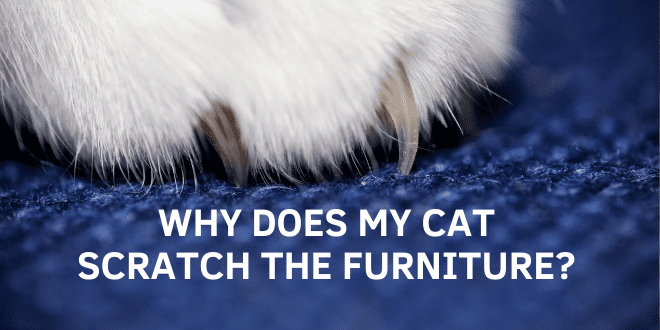
Furniture scratching. So many people are convinced this is a behavior displayed by cats just for the sheer thrill of destroying the living room sofa or treasured antique chair. If you live with a cat who has turned your upholstery into mere shreds, you’re probably at your wit’s end in terms of whether keeping him means abandoning all hope of ever having intact furniture again.
The problem is that you might’ve gone at this the wrong way. You were trying to train your cat to NOT do something that is actually a normal and essential part of being feline.
Scratching is a Normal Behavior for Your Cat
Scratching is important and more complex than you may realize. You might be under the misconception that scratching is merely a cat’s attempt to sharpen claws to razor-sharp perfection or that the behavior is based on a willful attempt to get back at you or destroy the surroundings. If you view the motivation for scratching as just a willful act of destruction, you run the risk of damaging the relationship you have with your cat because he’ll become afraid to scratch in your presence to avoid physical or verbal punishment. Since the cat still have a natural need to scratch, the behavior will still be done but it’ll occur when you aren’t around.
Don’t Resort to Declawing
Having claws is a vital part of a cat’s physical and emotional health. Declawing is a cruel and inhumane practice and is the equivalent of amputation. Pain can last long after the healing process and may even continue for the rest of the cat’s life. The Journal of Feline Medicine and Surgery published research indicating that declawing increases the risk of long-term or persistent pain, which can result in behaviors such as litter box avoidance, aggression/biting and over-grooming. Here’s the study if you’d like to read the results: Pain and Adverse Behavior in Declawed Cats
Scratching is Good for the Claws
When a cat scratches on an object, it removes the outer dead sheath of the nail and exposes the healthy new growth underneath. If you look at the location where your cat likes to scratch, you may find several half-moon shaped nail sheaths. Scratching is how a cat maintains the health of the claw, so don’t be under the misconception that banning a cat from scratching will keep the nails blunt. The nails will still grow but scratching will help keep them healthy.
Scratching Enables a Cat to Stretch
In addition to conditioning the claws, it’s a very effective way for a cat to stretch his back and shoulder muscles. Imagine how good it must feel to be able to fully unkink those muscles after sleeping in a tight little ball.
Scratching Serves as a Marking Behavior for Cats
The marks left on an object when cats rake their claws vertically create a visual sign for others who pass by. In an outdoor setting, these visual markers are important because they show approaching cats that they’re entering an area where another cat has been or is currently residing. This advance warning system can reduce the number of actual physical confrontations cats may otherwise have. The visual mark can be seen at a distance. Scratching also creates an olfactory mark as the cat presses his front paws onto an object to scratch. There are scent glands in the paw pads that release pheromones as the cat scratches. Any approaching cat who comes close enough to the scratched object will be able to get valuable information about the cat who did the scratching.
Scratching is a Stress-Reliever For Cats
Scratching is used as an emotional release or displacement behavior. When cats are anxious, happy, excited or frustrated, they can release some of that built-up emotion by scratching. Think of the times you’ve seen your cat scratching on an object as you prepare dinner or when you’ve come home from work. You may even have noticed one cat scratching after an encounter with a companion cat. This ability to have an emotional release through scratching is healthy for the cat.
Since scratching is so complex, and a vital part of feline life, you’ll need an effective training method to redirect your cat. You can’t just shoo a cat away from the sofa. You have to provide a scratching post that meets his needs. The behavior training technique begins by providing a scratching post that that meets the qualifications:
- appealing texture
- tall enough
- stable
- placed in a good location
In general, the most appealing texture for cats is sisal. The rough texture makes it easy for cats to dig their claws in and get an effective scratch. Carpet-covered posts are too soft and don’t meet the needs of most cats when they’re looking for a place to scratch. Additionally, many cats end up getting their claws caught in the carpet loops.
Not Just Any Scratching Post Will Do
The height of the scratching post should enable your cat to get a full stretch. If the post is too small the cat has to hunch over to use it and that doesn’t allow for a good back and neck stretch. If that’s the case, he will probably seek out a taller option, and I’ll bet you can figure out what that option will be – your sofa! Make sure the tall post is also very stable. A tall post needs a wide base in order to prevent it from toppling over the first time a cat leans against it.
Location Matters When it Comes to a Scratching Post
Even a great scratching post will just gather dust if you stick it in some far off location. When a cat needs to scratch he’ll look for the closest object that meets his needs. Keep the post where a cat likes to spend time.
Provide more than one scratching post, especially if you have a larger environment. If you have more than one cat, you’ll most definitely need multiple posts. Although you can’t specifically assign a post to a specific cat, if you place the posts in areas where each cat tends to spend the most time, you may find they may just claim the posts on their own. In general, position posts in socially significant areas of the home. The more conveniently located, appealing posts in your home, the better.
Horizontal Scratching
For cats who like to scratch horizontally, there are inexpensive corrugated cardboard scratching pads available at your local pet product store and online. These are great options for cats who tend to scratch on carpets, welcome mats, and along the tops of upholstered furniture. Even for cats who scratch vertically, it’s beneficial to offer some horizontal scratching options. The corrugated cardboard scratching pads come in a variety of shapes, including inclines, u-shape, flat, and even figure-8. For added enticement, most cardboard scratching pads come infused with catnip or have a package of catnip included so you have the option of whether to rub it on the pad.
Training Your Cat to Scratch on the Scratching Post
If your cat has been scratching a piece of furniture, place the scratching post right next to it. You can cover the piece of furniture with a sheet. You can also use double-stick tape made especially for furniture. This way, when a cat comes over to scratch the furniture, he’ll see the area isn’t as appealing and at the same time, he’ll notice the much better option in the form of a top of the claw-friendly post.
If using a sheet to cover the furniture, tuck it in securely to prevent the cat from getting underneath. You can use some narrow PVC tubes to tuck between the cushions and the back/sides of the chair or sofa to keep it in place. Another option is to purchase a slipcover, but it needs to be a sleek material that isn’t claw-appealing.
To entice a cat to the scratching post, start by doing some playtime around it with an interactive toy. Run the toy along the post to encourage a cat to dig his claws in. If your cat likes catnip, rub a little of the dried herb along the post.
One very important aspect of training a cat to use a scratching post is to NEVER punish for scratching furniture. Scratching is a normal, needed behavior and if you punish a cat, he’ll still retain the need to scratch but may just resort to doing it in secret. Punishment also breaks the bond you have with your cat as you run the very high risk of having him become afraid of you. Train your cat by providing what is needed so that natural, beneficial aspect of cat life can be fully enjoyed.
Need More Information?
For more information on cat behavior and training, refer to the best-selling books by Pam Johnson-Bennett. Pam’s books are available at bookstores and online. We’ve included Amazon links here on our website.
If you have a question regarding your cat’s health, please contact your veterinarian. This article is not intended as a replacement for your cat’s veterinary care. This article is for information purposes only and not offering medical advice or providing a medical diagnosis.





